Table of contents
- Introduction
- Trips and Places
- Offers
- Admissions
- Reservations
- Ancillaries
- Linking Admissions, Reservations and Ancillaries
- Fees
- Products
- Fares
- Complaint
- Coach Layout
- Reimbursement
- Release
- Putting Prebooking on Hold
- Ids and References
Introduction
This page shows a representation of the data models underlying the API specifications. It is therefore not a strict representation of the resources themselves (those are self-represented in the OpenAPI specifications.)
As such, some of the details of how the information is structured in the API are not represented or simplified in the data models. The main purpose of this data model is therefore to help a quicker understanding of the API and its underlying concepts.
Legend

Trips and Places
Places Data Model

Places
Places are resources representing a specific location in a trip: departure, origin, intermediate stop or other. They can be of different types:
-
Address: any street address can be represented here. Is included to foresee extension towards multi modality and first/last miles solutions
-
PointOfInterest: used to represent a specific point of interest
-
StopPlace: represent a place where a train or a bus stops. It is obviously the most relevant type for OSDM. StopPlaces can be indicated as codes from different code sets. As with other code list based representations in the API, using the UIC code set is highly recommended and mandatory for train stations.
-
GeoCoordinate: allows providing any location on the globe using its geographical coordinates.
-
FareConnectionPoint: allows to model virtual border points by defining stations within the connection point lies.
Places are modelled in the API as resources with a long time-to-live, which should allow efficient caching of this data, therefore removing the need of getting full location details in transactional operations.
Trip Data Model
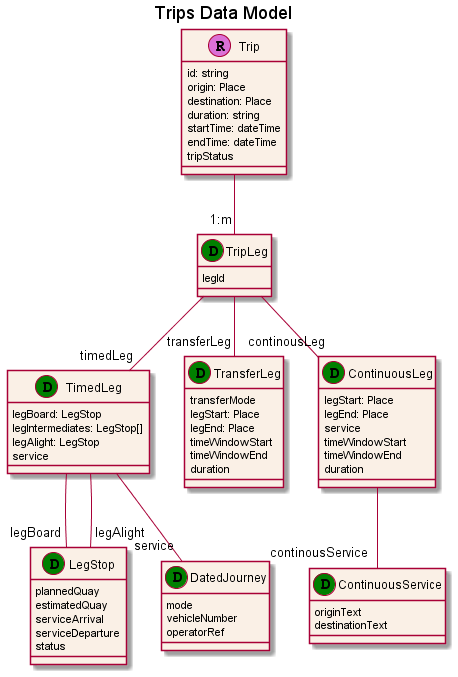
Trips
Trips represent the concrete realization of a trip going from departure station to destination station.
- origin: departure location of the tripLeg
- destination: arrival location of the tripLeg
A trip is composed of one or more tripLegs and can be of one the following
type:
- TimedLeg: A type of leg with a timetable schedule such a provided by public transport
- TransferLeg: A type of leg that links two legs such as walking from one stop to another
- ContinousLeg: A type of leg that is not bound to a timetable. This leg is mainly aimed at new modes such as scooter, taxis,..
Each tripLeg (also sometimes called leg) represents a connection between two
places where the traveller will either step in a transport or step out of a
transport (most likely a train).
Regardless of whether the products to travel these tripLegs are train-bound, or based on with a validity period of any duration, tripLegs (and by extension trips) are always train-bound and represent the realization of the travel wish using specific trains at a specific moment in time.
Trips can be retrieved with or without details of all intermediate stops on the
way between departure and arrival of each tripLeg.
A trip can be in states planned, confirmed, changed or cancelled.
Offers
Data Model
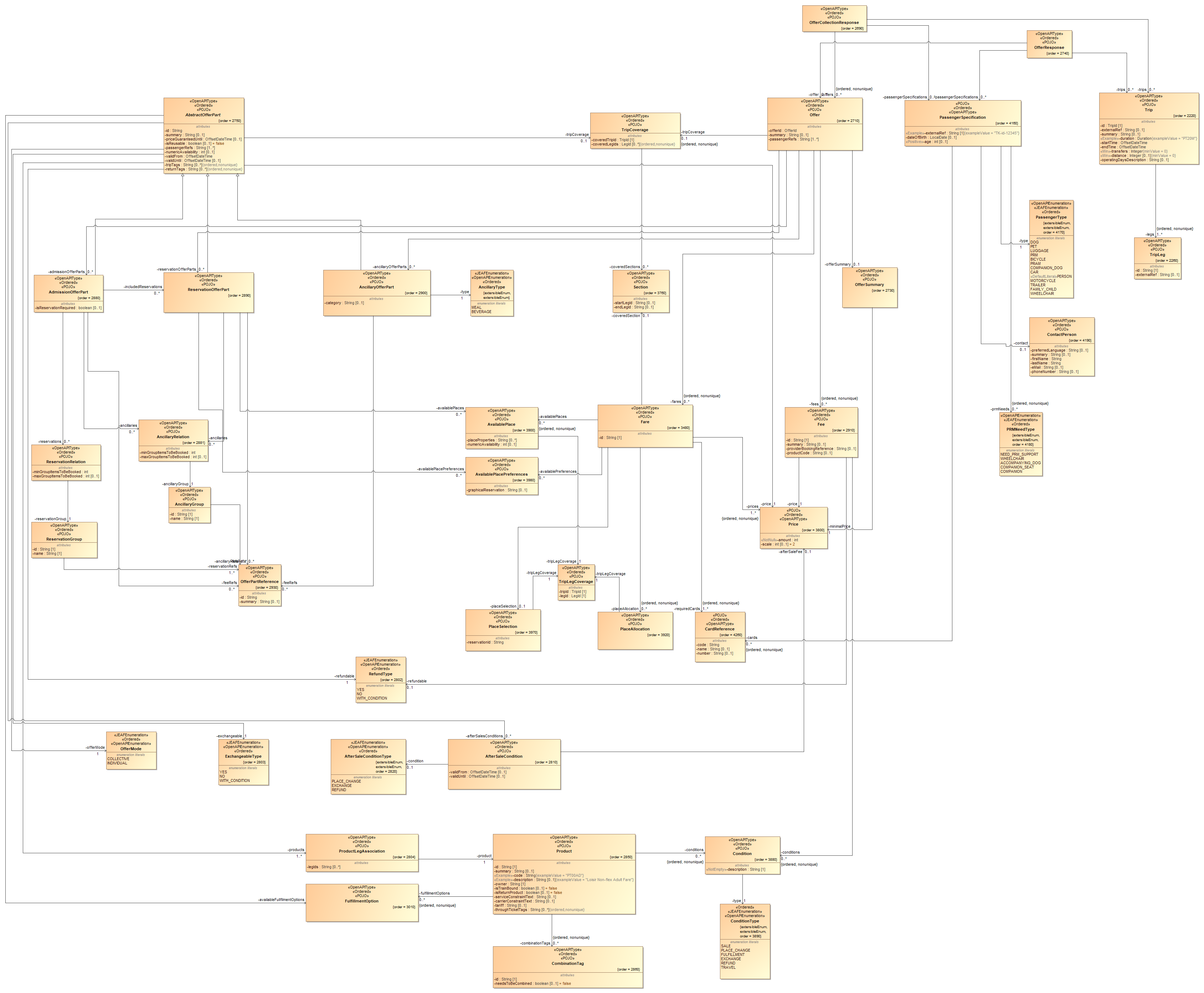
Offers
In Retailer Mode, offers represent a collection of OfferParts,
representing bookable elements that covers exactly one a specific trip (or the
requested section of a trip in case of request to a FareProvider). Note that the
offer contains a reference to the trip resource it is built for, although this
reference can be redundant when the TripOffer the offer is part of is already
known to the API consumer
Some of these elements can be optional (see further).
In Distributor Mode, an offer will not contain offer parts but it will contain a fare element, that the distributor can use to build the final product to be sold to passengers. There can also be hybrid situations where offers will contain both offer parts and fares if the provider offers product in the two flavors.
In some cases, API consumers will be required to provide some additional
information in order to proceed with the provisional booking. In this case, the
information needed will be specified in the requestedInformation element using
a notation akin to regular expressions, which has a defined
grammar.
Offers should always contain a minimalPrice (= the price of the offer without
any of the optional offer parts), a global service class and flexibility.
Although the calculation rules for these global values are up to the OSDM
provider, the following rules are recommended:
-
ServiceClass: the lowest class of a significant offer part should be the service class of the offer (1st class + 2nd class = 2nd class) -
Flexibility: the lowest flexibility of a significant offer part should be the service class of the offer (full flex + mid flex = mid flex)
Offers usually have a validity period, that is the period over which, from the fare conditions, the offer is likely to be proposed. It is not a guarantee that the offer remains available for that period
Offer resources and all related resources (TripOffers and all sub resources)
should have a limited lifetime (recommended value 30 minutes) and be discarded
when expired or at booking time.
TripOffers
TripOffers are the resources grouping all the offers relating to one same
trip. Indeed, in most cases the Distributor provider will propose several
offers of different comfort and flexibility levels. In this resources, the trip
resource representing the trip the offers are for and the passengers for the
trip.
Offers with Partial Coverage
It is possible in OSDM to propose offers covering only a subset of the requested trip under specific conditions:
- the tripLegs covered by a given offer are indicated through the
coveredTripLegIndexesproperty - all offers covering the same set of tripLegs belong to the same
offerCluster. All offers related to the sameofferClustertherefore have an identical set ofcoveredTripLegIndexes - a
tripLegcan only be covered in oneofferClusterwithin atripOffer(no overlap) - each
tripLegof thetripmust be covered by at least oneofferin eachTripOffer(no gap)
Example with no overlap

Example with no gap

OfferParts
Although OfferParts are by themselves not a resources, they deserve a separate
section in order to for the reader to clearly understand the data model design.
The idea is that OfferParts represent an instantiation of a product that can
be sold.
Example
-
A carrier proposes an “Early bird Holiday Fare” product for all its high-speed trains riding towards the seaside of the country, offered when sales date is at least 15 days prior to travel.
-
Whenever an offer request is received and this fare can apply, an offer part is created and proposed, specifically to the date, origin and destination of that specific request, and referencing this product. As such it is therefore the offer part that for example will carry the actual price.
These offer parts can be of different type, depending on what they represent:
- Admissions
- Reservations
- Ancillaries
- Fees
However, all these different type share a significant amount of characteristics: they all apply to a defined set of passengers, have a price (calculated individually or collectively), and a few additional attributes. They also fill in the same fundamental role in the offer, which is why they are represented here as an abstract parent class.
Multiplicity
In OSDM, offer parts are not normalized, but will reflect the reality of the products generated. This means that one offer part will almost always equal one fulfillment in the resulting booking, should it be completely realized and confirmed.
So, two passengers traveling together happen to get exactly the same product (because their profile is identical in terms of age, reductions etc), will still get two individual offer parts (one per passenger) if the product covered has individual pricing and fulfillment, while they would be grouped in one offer part in case of collective pricing and fulfillment. (see examples at the end of the offer section)
Offer Parts - Admissions
Admission offer parts represent a travel right, or the entitlement to travel onboard a train between the given origin and destination, following the given route, without a seat reservation. In most cases, these train products will not be train-bound either.
In some vehicles, seat reservations or an ancillary products (such as a WIFI connection or a meal onboard) can be associated with the admission for one or more of the tripLegs. A link will in this case point from the admission to the reservations or ancillaries, and the link will be qualified. Ancillaries can be either included or optional, while reservation can also be mandatory to travel. Finally there can be a cases where all reservations associated are optional while it is mandatory to pick at least one (it can be the case for night trains for example). This is expressed by linking the reservations to the admission via Linking Admissions, Reservations and Ancillaries.
Offer Parts - Reservations
Reservation offer parts represent seat or other accommodation type reservation on the transportation. It might contain multiple seats/places. In contrast with admissions, a reservation is in essence bound to a specific train, although it does not include the entitlement to board the train. Passengers therefore typically need an a associated admission offer part or other entitlement (such as a pass) in order to actually travel.
A reservation always relates to a single leg, i.e. the tripCoverage attribute
of the ReservationOfferPart can only refer to a single leg, even though the API
syntax allows to specify multiple entries for tripCoverage.coveredLegs, due to
the fact that TripCoverage is used for all offer part types.
Note booking an offer will not book the reservations in the offer unless they
have an included relationship with an admission of that offer. In order to add
a non-included reservation to a booking, the reservation ids will have to be
passed in.
Reservations have several additional attributes due to their specificities compared to admission products:
-
Reservation Details provide additional information on the accommodation type and, once the offer will have been booked, the exact reserved places, with their properties and links to the concerned passengers
-
Place selection Details: contains several elements related to the selection of places:
-
placeSelection/ReservationOptionsshow, at offer retrieval stage which options are available for this reservation. -
SelectedOptionsallows the API consumer to specify desired options. -
SelectedPlacesindicates selection of specific places (probably only relevant in case of graphical place selection.
-
Modelling Lump Sum Reservations
For some trains, especially in Germany, Austria and Switzerland today, a specific form of reservation booking can be found where the price for adding an optional or mandatory (but not free) reservation remains the same regardless of the number of legs, i.e. changes. So, the price for the reservation is the same if the trip is A-B B-C or A-C without change. In order to represent this type of reservation with the current model, two approaches are proposed to implementers:
-
Generate one reservation offer part per leg with a price of zero, and add the total cost for all reservations to to the admission offer part. This would be the regular case for IRT (Integrated Reservation Ticket). The disadvantage of this approach is that the customer cannot opt out of all reservations and lump sum.
-
Generate one reservation offer part per leg with a price of zero, and generate a fee offer part object in addition to this which carries the reservation price. The reservation offer parts link to the (common) fee offer part. With this approach the customer can opt out of all reservations and, if they choose to do so, do not have to pay the reservation fee.
These approaches allow to not propose reservations if there are none available on one of the tripLegs, while still offering the offer for the complete trip with reservations on all tripLegs where it is available. Customers can also elect to not reserve seats on single legs (e.g. short legs if they cannot be bothered to search for the correct coach number).
Offer Parts - Ancillaries
Ancillaries are used to represent non-transport products associated with the transportation request submitted. It could be onboard services such as a WIFI connection or a meal, or services associated with one of the stops, or origin/destination, like a parking spot or lounge access.
This offer part is significantly simpler than those instantiating transport products, and only has one additional attribute, being the category of the ancillary.
Offer Parts - Linking Admissions, Reservations and Ancillaries
Rerservations and Ancillaries might depend on the each other or on Admissions. E.g. an optional ancillary offer representing a bicycle transport might depend on reservation offers for the bicycle hook on the train.
These dependencies are described via the AncillaryRelation and ReservationRelation objects. The Relation objects allow to define groups of parts from which some need to be choosen.
Example 1:
An ancillary depending on reservations with specific service. The ancillary is priced independent from the number of reservations:
- admissionOffer:
- in case of mandatory reservation:
ReservationRelationtoReservationGroupwith reservation 1,2ReservationGroupwith reservation 3,4
- in case of mandatory reservation:
- ancillaryOffer 1 (optional):
ReservationRelationwith reservation 1,2
- reservationOffer 1 (optional), train 1 with ancillary support
-
AncillaryRelationto ancillary 1 - reservationOffer 2 (optional), train 2 with ancillary support
-
AncillaryRelationto ancillary 1 - reservationOffer 3 (optional), train 1 without ancillary support
- reservationOffer 4 (optional), train 2 without ancillary support
In case the reservations with the ancillary can be on specific places only it is up to the provider system to ensure that appropriate places are reserved and shown in graphical reservation displays.
Example 2:
An admission which requires exactly one of several reservation options to be booked. The typical use case for this are night trains, where either a seat, a berth or a cabin needs to be reserved.
- admissionOffer:
ReservationGroupwith reservations 1,2,3 and minGroupItemsToBeBooked = maxGroupItemsToBeBooked = 1
- reservationOffer 1 for a seat
- reservationOffer 2 for a berth
- reservationOffer 3 for a cabin
Offer Parts - Fees
Fees are used to represent additional costs for services or products. Offer parts of type “fee” can be applied to the booking process (e.g. a service fee), the trip (e.g. a reservation fee which is applied to all reservations in trains running in the same direction, namely outward or inward travel, see Modelling Lump Sum Reservations) or other offer parts. In contrast to other offer parts in OSDM, the customer is not free whether to choose a fee or not: fees are generated and applied to other services or products by the provider system.
Products
Products are the products actually offered by the distributor. Products resources contain all the conditions and attributes of the product, regardless of the actual sale case. Typically this matches commercial products having the same name and recognizable common sales & after sales characteristics.
Although no manipulation is performed on products, it is nevertheless proposed as a resource mainly to allow caching of the information. Indeed, since product information usually does not change too frequently (and usually at well defined dates), those resources can then be exposed with a significantly longer time-to-live and save significant bandwidth. It also allows for a “product catalog” functionality to be built by the API consumer, should he want to do that.
Fares
Fares should be seen as the counter part of OfferParts in case of interactions
between an distributor and a fare provider. The key difference here is that
where offer parts are products defined by the provider and fulfilled by it as
well, the fares do not constitute a distributable product. It is up to the
distributor to build the distributable product (that he could then sell as an
offer part to a retailer), based on one single fare or by combining fares coming
from different providers. In consequence, the fulfillment of the resulting
product is the responsibility of the distributor as well.
Distribution systems which also act as retailers might encapsulating both fares and offer parts in offers allowing to have a similar flow of interactions regardless of the type of provider.
Fares provide all information needed to be combined by an distributor and to allow an distributor to create fulfillments and support of control processes (e.g. providing combined control data to the TCOs). This especially includes the temporal and regional validity for travel. The rules on how to combine the fares (combination constraints) must also be included in the fare.
Regional Validity Route model
The route in fares is modeled as a structural model to allow additional functionalities including automated ticket control or validation of new trips with the described route. The model is compliant with the route model used in the FCB bar code data and the IRS 90918-4 ticket data exchange for control.
The data model makes use of recursive definitions to simplify implementations but the message contains a non-recursive representation of the data where recursive links have been replaced by a reference to an index in a list.
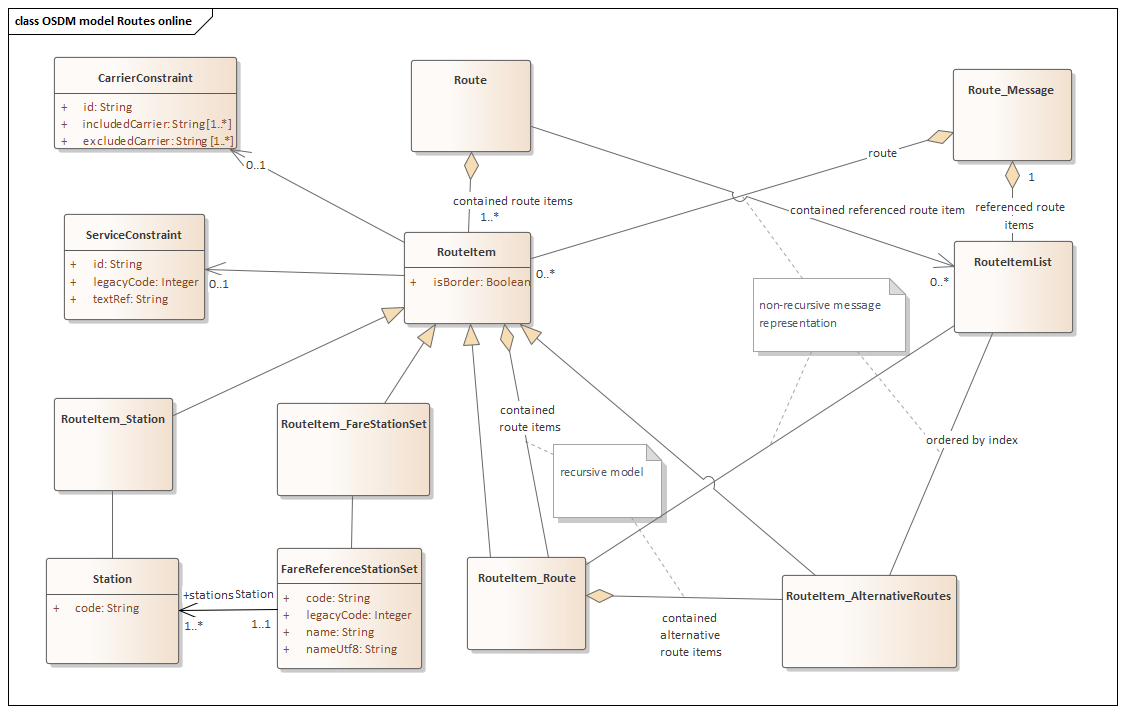
For the following example object models are shown for the message representation and the recursive model:
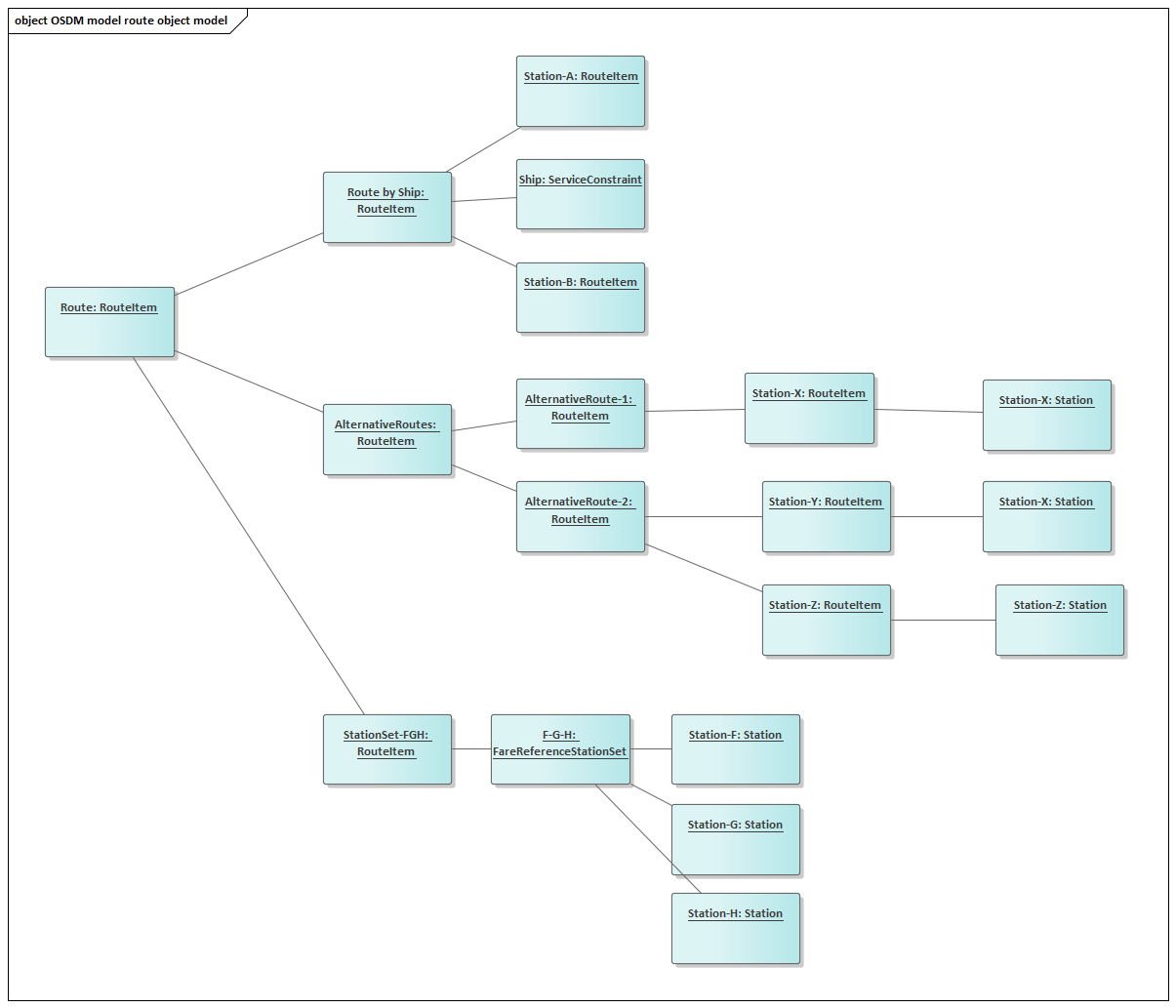
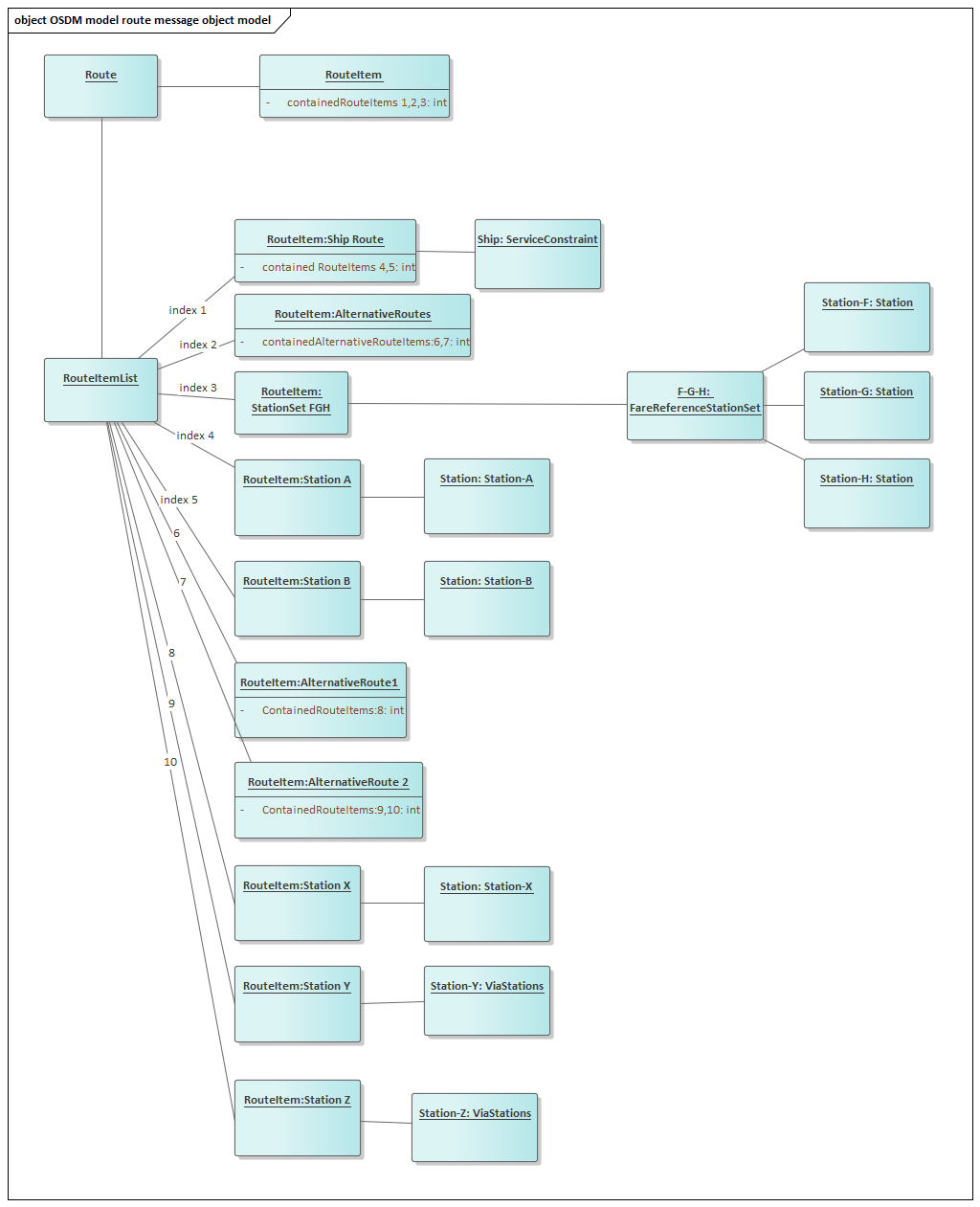
Passengers
As the name suggests, passenger resources represent the passengers for whom the offers are proposed. All offers generated are always proposed for the complete set of passengers (no partial offers covering only a part of the passengers is generated). However, it is possible that because of age, reductions or other, some passengers are allowed to travel some tripLegs without actually needing a travel right or reservation. It is for example usually the case for infants traveling on their parents lap.
While a lot of attributes can be set for passengers, only a few are required at
this stage (and even later). The key elements at offer stage are already
specified in the offer request. The link between the possibly anonymous
passenger profiles (in most basic form: a unique (in the booking) reference,
age and reduction entitlement if any) created in the offer request and the
passenger resources in the TripOffers can be made based on the passenger
reference attribute.
The passenger resources created in the context of offers have their lifetime strictly limited to the lifetime of the offer resource they are part of. The resource and all local traces of it should be discarded once the offer has been booked or reached the end of the lifetime, in order to avoid any privacy concern.
Passengers Representation
In the railway world, several elements are used to define a passenger profile (mostly in order to define the products it is entitled to):
- the passenger’s age
- the reduction cards the passenger owns
- whether the passenger is a reduced-mobility or otherwise disabled passenger
- other specific status entitling to specific fares (military, senator, journalist…)
While in some systems, all the notions above are mixed into one “passenger type” notion, this approach is much more difficult, and cumbersome, to apply when multiple providers are involved, which is highly likely with OSDM. Indeed, different systems often have different age limits for types, and different ways to represent the other elements. For this reason, in OSDM we decide to map the elements above to two kinds of attributes:
-
Passenger birth date, modelled as-is in the API. Note it could be a dummy birth date. Each implementer is then free to map this value to the age-related passenger types he is using internally
-
Some attributes related to passengers disabilities (for accommodation purposes mainly)
-
All other notions are modelled as reductions. Again, each implementer can map internally this clearly defined notion to the internal representation.
The presentation hereunder provides some additional examples of high-level offer modelings for pure-OSDM offers.
Booking
Booking Data Model

Main Resources
Booking
The booking represents the offers that have been selected and turned into a booking on request to the provider of the offers.It contains a set of sub resources, most of which were encountered in the offer stage. but also adds a few specific attributes and information, the most important undoubtedly being the booking status (see state models). The booking will indeed evolve over time based on API consumer actions, time elapsed or other business events.
The booking contains additional attributes that are needed to manage fulfillment options.
Booking Time Limit for confirmation
The booking contains confirmation time limit needed to manage and control the confirmation of the booking when it is in provisional state.
The confirmation time limit is the time during which the booking is guaranteed to remain available for confirmation for the price and possible reservations assigned at provisional booking time. Basically, it is the time given to the API consumer to perform all updates needed to confirm the booking, and trigger that confirmation. (The confirmation time limit is referred to as ticket time limit TTL in other contexts)
In an environment with multiple OSDM providers the minimal time limit of all providers needs to be displayed for the customer. The confirmation time limit might be extended by some providers when changing a provisional booking.
The time limit within a booking part has been deprecated by version 3.3 and should not be used any more. A API consumer should work with the time limit in booking only.
Booking Prices
At the root of the booking structure, balance elements are provided to clarify the state of the financial exchange between a Retailer and the Distributor:
- provisionalPrice: the sum of the prices of all booking parts that are provisionally booked. This includes booking parts from exchange operations.
- provisionalRefundAmount: the sum of refund amounts of all prebooked but not confirmed refunds and exchange operations.
- confirmedPrice: The sum of the prices of all confirmed booking parts including confirmed parts from exchange operations minus the sum of all refund amounts from confirmed refunds or exchanges.
Also located at the root of the booking structure is the ticket time limit. This is the time for which the provider will hold a booking in pre-booked state, waiting for the confirmation while guaranteeing the booking for the given products, spaces at the announced price. Obviously, this value only has a meaning for a booking in pre-booked state. A commonly accepted value would be around 30 minutes, which is normally sufficient to allow finalizing the booking,while not monopolizing resources too long in case the booking is abandoned without properly cancelling it. However, some systems may decide a longer time. Obviously, the value for the booking ticket-time limit can never exceed the earliest ticket time limit of any of its offer parts.
FulfillmentOptions allows the API consumer to specify the format desired for
the fulfillment. Only electronic fulfillment is considered in the MVP scope.
Purchaser
A purchaser represent the entity which has booked an offer. It is the person to contact in case of changes to the booking primary.
A purchaser does not need to travel thus is not necessary a passenger.
Common attributes of a passenger and a passenger are factored in the person entity.
BookedOffers
BookedOffers are actually the same resources as the offers except that they
are now booked. Most of the resource remains unchanged, except for the sections
on reservation details (either in reservation Offerparts, or in fares), where
but the sections related to the reserved places (in reservationDetails) will now
be populated with the references to the space allocated by the provider system
where the transport product is hosted.
Fulfillments
Fulfillments could once have been called tickets. But the evolutions in the
industry have led this to be a limitative naming, as various kinds of ticketless
onboard controls are rapidly taking over and become the norm rather than the
exception. Since in OSDM only the sales part of the process is in scope, the
details of how to produce or control fulfillment are not covered. From a
distribution standpoint, the only needs are
The possibility to point at a fulfillment representing an offer part (= the id) for after sales operations. The capability to link this fulfillment to that associated offer part they relate to. A business identifier that can be used in associated processes. For railways, that would be the Ticket Control Number (TCN).
Links to the documents or other security features that can be used to represent and control fulfillment status. In most case it is a PDF document and/or a barcode. These are all provided in the fulfillment sub resource.
Passengers
The passengers sub-resource in the booking is actually the same as the one in the tripOffers, but it is worth mentioning it separately here as
- being a sub-resource, it will have a different path
- as mentioned in the section about offers, the passengers in the
TripOfferswill disappear with the booking or the time-to-live expiry of the offers, and the passengers created in the booking will have a different id.
RefundOffers
Refund offers represent a provisional refund request that is made on all or a subset of the fulfillments contained in a booking.
ExchangeOperations
An exchange operations represent an ongoing exchange process, either in provisional state of in confirmed state (depending on its status). Much like a provisional booking, a provisional exchange contains the provisionally selected (new) Exchange Offer, a status and a ticket-time-limit. In addition, it also contains a reference to the fulfillments that are involved in the exchange, and will be cancelled as a result of its confirmation. Confirmed exchange operations are very similar, except for their status that will change, obviously, and the fact that the exchangeOffer is then transformed into a booked Offer in the booking and only referenced in the exchangeOperation
Exchange Offers
The exchange offers (and related models such as exchangeTripOffers) are totally similar to their offer counterpart, with the difference that ExchangeOffers also have a link to the fulfillments involved in the exchange operation, and also have 2 additional attributes for the exchange fee and exchange balance (= the difference between the value that can be returned form the fulfillment and the value of the current offers + the exchange fees = the total amount to be paid or refunded if/when confirming the exchange)
Coach Layout
Coach layouts describe the static layout of a coach and are used for graphical reservation.
Coordinates are horizontal left to right with x=0,y=0 in the top left corner:
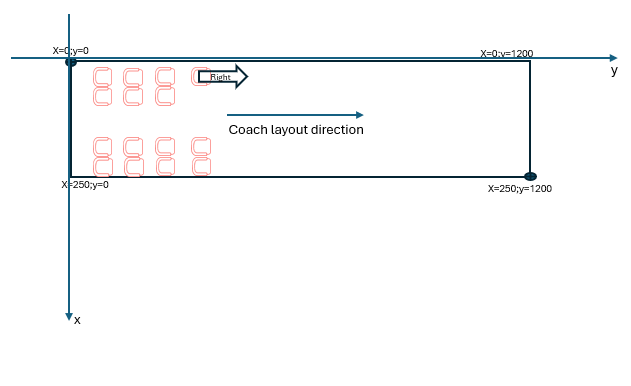
Width is defined on the x-axis. Orientation (see catalog of code list) of an icon is relative to the landscape layout mode. Landscape rendering means that the width of coach is layouted/rendered vertically. coach layouts which are defined in portrait layout mode should be transformed, so that all parties get layouts in landscape mode via the OSDM APIs.
The graphics items to be placed in the layout are defindedin : code lists: graphics items).
The icons, internals and places orientation is defined as:
- RIGHT facing y-axis positive direction
- LEFT facing y-axis negative direction
- UP facing x-axis negative direction
- DOWN facing x-axis positive direction
Complaint
A complaint can be filed by a passenger in case of delay/disruption or service derogation for a booking or parts of it (e.g. in case of a return trip). A passenger can provide documentation to support the claim (e.g. scanned manual remark of train staff) and it must able to lookup the status of the claim made.
If a claim is accepted or rejected the system that made the request must be informed. The accepted or rejected claim must provide an explanation for the decision especially if the amount covers the ticket price only partially.
Reimbursement
A reimbursement can be filed by a passenger in case his booked tariffs allows for a refund on unused or partially unused tickets. A passenger can provide documentation to support the request (e.g. scanned manual remark of train staff) and he must able to lookup the status of the request made.
If a request is accepted or rejected the system that made the request must be informed. The accepted or rejected request must provide an explanation for the decision especially if the amount covers the ticket price only partially.
Release
A release of a booking is an intermediate step toward a refund. It invalidates tickets and frees booked resources (e.g. reserved places on a train). The release does not refund money to the customer and thus can be made by another party involved. The refund is then completed by the original retailer. The benefit for the customer is that the time of the release is used to calculate the refund amount.
Putting bookings on Hold
An unconfirmed booking expires after the time limit of the pre-booking. It is possible to ask for an extension of the time limit and the provider might grant the extension. He has the option to add a fee for this extension.
Ids and References
| Object | ids | description | |
|---|---|---|---|
| Place | id | id defining the place. The code is provided as URN, relative URNs are allowed with base path urn:uic:stn ‘8500001’ | |
| Place | alternativeIds | For a place with ids in different reference systems, the alternative ids can be returned. The reference system is encoded in the string. E.g.: “urn:uic:std:8000001”, “x_swe:stn:10000”, “ch:1:sloid:343434” | |
| TripCollectionResponse | id | included to be compliant with OJP, no use | |
| Trip | id | id of the trip | |
| Trip | externalRef | external reference of the trip, e.g. provided by a time table provider / engine | |
| Trip | situationFullRefs | references to situation messages (outside of OSDM) | |
| TripSummary | id | id of the trip that is summerized | |
| TripSummary | externalRef | external reference of the trip summarized, e.g. provided by a time table provider / engine | |
| TripLeg | id | id of a leg in the trip. Unique within the trip only. | |
| TripSpecification | externalRef | Referencing a Trip via the Trips id | |
| TripLegSpecification | externalRef | Referencing a TripLeg via the TripLegs id | |
| Section | externalTripRef | Referencing a Trip via the Trips id | |
| Section | startLegId | Referencing a TripLeg via the TripLegs id | |
| Section | endLegId | Referencing a TripLeg via the TripLegs id | |
| AnonymousPassengerSpecification | externalRef | Reference to a passenger provided by the API consumer. Unique within the context of one Offer/Booking. Must not reference a passenger in a broader context due to GDPR regulation | |
| Offer | offerId | Id of the offer given by the provider. | |
| Offer | passengerRefs | reference to the passengers via the externalRef of the AbstractPassengerSpecification | |
| Product | id | Id of the product | |
| TripCoverage | coveredTripId | reference to the trip via the id of the trip. | |
| TripCoverage | coveredTripLegIds | reference to the covered TripLegs within the referenced Trip via the TripLeg id | |
| AbstractOfferPart (AdmissionOfferPart, ReservationfferPart, AncillaryOfferPart) | id | id of the offer part | |
| AbstractOfferPart (AdmissionOfferPart, ReservationfferPart, AncillaryOfferPart) | passengerRefs | reference to the passengers via the externalRef of the AbstractPassengerSpecification | |
| Fee | id | id of the fee | |
| Fee | distributorBookingRef | useless | |
| Fee | productRef | reference to the product via the produt id | |
| Fare | id | id of the fare | |
| Product | id | id of the product | |
| Coach | layoutId | reference to the coach layout via the id of the CoachLayout | |
| BookedOfferReservationRequest | offerId | reference to the offer from which the reservation offers parts are taken via the Offer id | |
| BookedOfferReservationRequest | reservationOfferId | reference to the reservation offer part via the ReservationOfferPart id | |
| BookedOfferReservationRequest | passengerRefs | reference to the passengers via the externalRef of the AbstractPassengerSpecification | |
| Booking | id | id of the Booking | |
| Booking | externalRef | reference to the booking provided by the consumer | |
| Booking | bookingCode | short booking identifier by the provider of the booking. Human readable and unique within the provider context and for a limited time only | |
| BookedOffer | offerId | id of the BookedOffer. Note: The BookedOffer id is different from the Offer id | that was used to create the BookedOffer |
| BookingRequest | externalRef | reference of the consumer to be included in Booking as externalRef | |
| AbstractBookingPart (Admission, Reservation, Ancillary) | id | id of the BookedOfferPart. Note: The BookedOfferPart id is different from the OfferPart id | that was used to create the BookedOfferPart |
| AbstractBookingPart (Admission, Reservation, Ancillary) | passengerIds | reference to the pssengers via the Passenger id. | |
| AbstractBookingPart (Admission, Reservation, Ancillary) | accountingRef | reference to accounting company e.g. in case the accounting company differs from the provider. | |
| Passenger | id | id of the passenger created by the provider | |
| Passenger | externalRef | external passenger ref btained from the consumer via the AbstractPassengerSpecification | |
| Fulfillment | id | id of the fulfillment | |
| Fulfillment | bookingRef | reference to the booking via th Booking id | |
| Fulfillment | controlNumber | control number given by the provider and unique within the provider context and for a short time only. The control number is used as identifier within bar codes. | |
